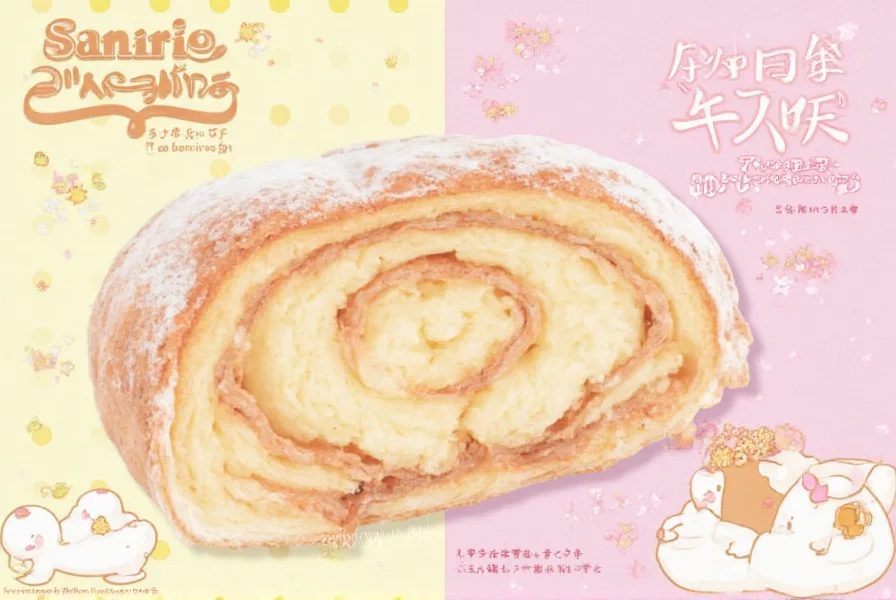Many fans search for Sanrio cinnamon roll products, hoping to find officially licensed baked goods featuring their favorite characters like Hello Kitty, My Melody, or Cinnamoroll. Understanding the reality behind these sought-after treats requires examining Sanrio's actual business practices and the creative food culture surrounding their beloved characters.
Sanrio's Approach to Food Products
Sanrio Co., Ltd., the Japanese company behind iconic characters including Hello Kitty, operates primarily as a character licensing business rather than a food manufacturer. While Sanrio characters frequently appear on food items worldwide, these are almost always the result of licensed collaborations with established food brands rather than Sanrio-produced goods.
The company maintains strict quality control over character usage, requiring partners to meet specific standards before approving character licensing for food products. This explains why you'll find Hello Kitty on Japanese Kit Kats, Sanrio-themed mochi, or character-shaped melon pan—but not on standard bakery items like cinnamon rolls through official channels.
Understanding Sanrio-Themed Bakery Creations
When searching for where to buy Sanrio cinnamon rolls, consumers typically encounter three types of offerings:
| Type of Product | Characteristics | Authenticity Level |
|---|---|---|
| Official Licensed Collaborations | Limited-time bakery partnerships with major chains in Japan or specialty stores | High (Sanrio-approved) |
| Independent Bakery Creations | Local bakeries creating Sanrio-inspired designs without licensing | Medium (fan-made) |
| Social Media-Inspired Recipes | Home bakers sharing Sanrio character cinnamon roll recipes | Low (unofficial) |
Cinnamoroll: The Character Behind the Confusion
The confusion around Sanrio cinnamon roll products often stems from Cinnamoroll, a popular Sanrio character introduced in 2001. This blue puppy with cinnamon roll-shaped ears and tail has become synonymous with baked goods in fan culture, despite Sanrio never producing actual cinnamon rolls under this character's branding.
Cinnamoroll's name and design intentionally reference cinnamon rolls, creating natural associations that fans and independent bakeries have enthusiastically embraced. Many bakeries create special Cinnamoroll-themed items during character anniversary celebrations or seasonal events, particularly in Japan and at Sanrio Puroland theme park locations.
Finding Authentic Sanrio Food Products
For those seeking genuine Sanrio food collaborations, consider these legitimate sources:
- Sanrio Puroland in Tokyo: The official theme park occasionally offers limited-time character-themed bakery items
- Sanrio stores in Japan: Major department stores with Sanrio sections sometimes feature seasonal food collaborations
- Licensed partner retailers: Stores like The Village Vanguard in Japan carry Sanrio-themed snacks
- Specialty import stores: Some international retailers import Japanese Sanrio food products
Be cautious of products claiming to be "official Sanrio cinnamon rolls" sold through third-party websites or social media marketplaces, as these are almost certainly unauthorized reproductions.

Creating Your Own Sanrio-Themed Baked Goods
For fans eager to enjoy Sanrio character cinnamon roll creations at home, many talented bakers have developed recipes that transform ordinary cinnamon rolls into adorable character representations. The most popular approach involves:
- Baking standard cinnamon rolls using your favorite recipe
- Using icing to create facial features of Hello Kitty, Cinnamoroll, or other characters
- Adding edible decorations for bows, ears, or other character-specific elements
- Referencing official Sanrio character designs for accurate representation
Several baking influencers have published detailed how to make Sanrio cinnamon rolls tutorials on video platforms, providing step-by-step guidance for recreating these charming treats. When searching for recipes, look for creators who respect Sanrio's copyright policies by emphasizing these are fan creations rather than official products.
Sanrio's Stance on Food Licensing
Sanrio maintains a selective approach to food licensing, prioritizing partnerships that maintain brand integrity. Their official food collaborations typically feature:
- Packaged snacks rather than fresh bakery items
- Short-term seasonal promotions
- Partnerships with established food manufacturers
- Products sold through authorized retail channels
This careful approach explains the absence of permanent Sanrio official cinnamon roll products in mainstream markets. The company focuses on maintaining character appeal rather than expanding into perishable food production.
Enjoying Sanrio Food Culture Responsibly
Fans can appreciate Sanrio's influence on food culture while respecting intellectual property boundaries. When sharing or purchasing Sanrio-themed baked goods, consider:
- Supporting official Sanrio food collaborations when available
- Acknowledging fan creations as unofficial interpretations
- Avoiding claims of official endorsement for homemade items
- Respecting Sanrio's copyright policies in all representations
The charm of Sanrio characters in food culture lies in the creativity they inspire among fans, not in official product lines. By understanding the distinction between licensed products and fan creations, enthusiasts can enjoy these delightful treats while supporting the brand appropriately.










 浙公网安备
33010002000092号
浙公网安备
33010002000092号 浙B2-20120091-4
浙B2-20120091-4